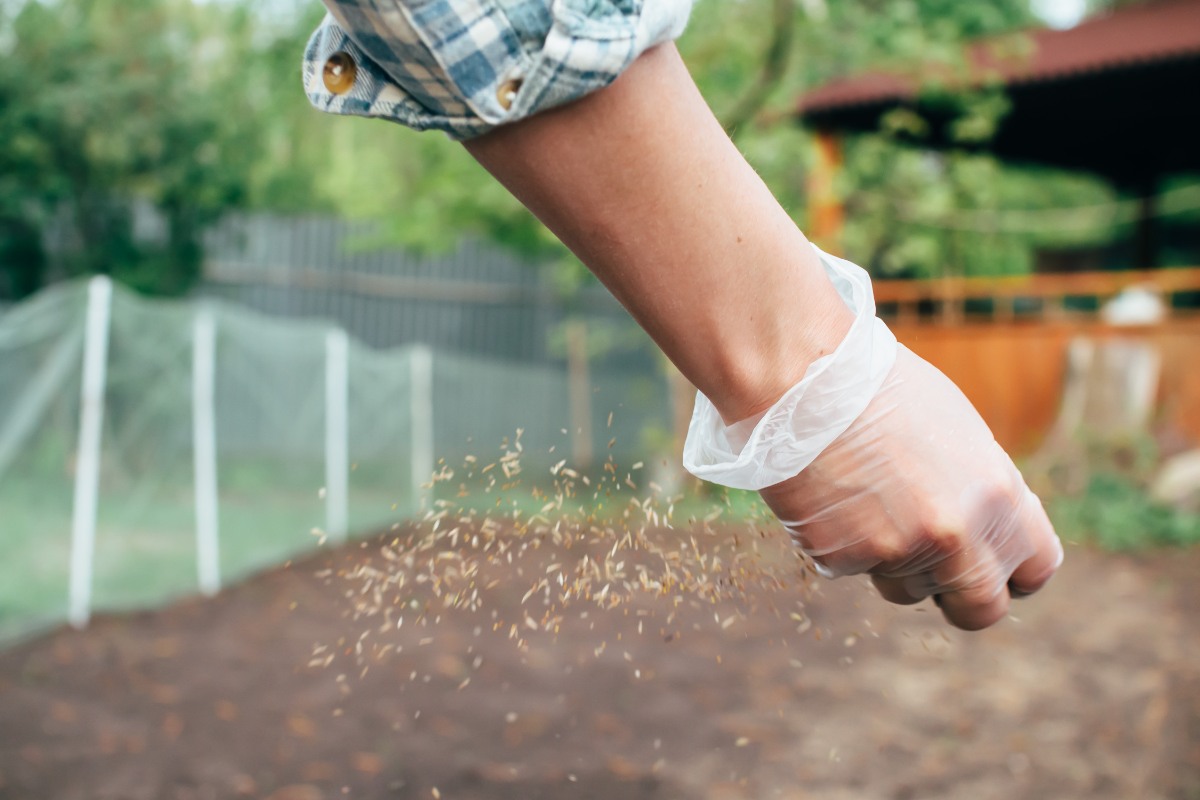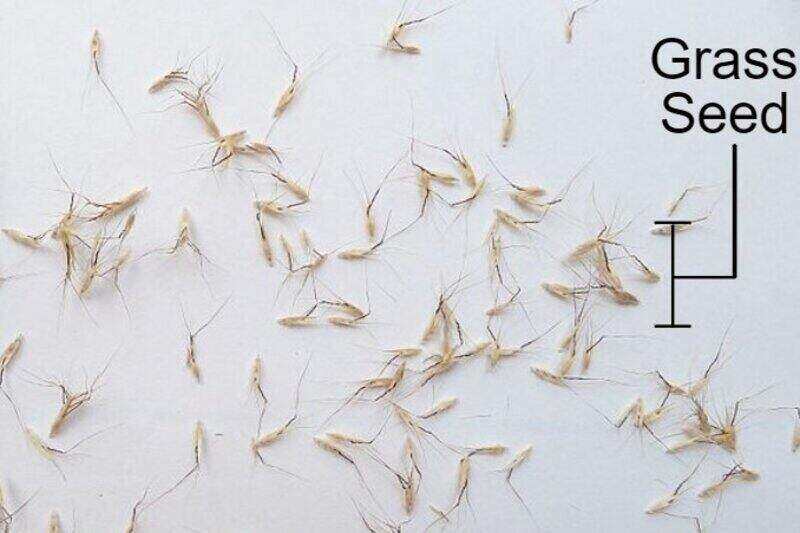
Overseeding without aerating saves time and money, but can lead to less than optimal results. To get the most from this overseeding method, prepare the seedbed carefully.
Mow short, dethatch, spread some topdressing to improve seed-to-soil contact, and rake the seeds into the soil afterward. We discuss all the important details of how to overseed a lawn without aerating to get thick, lush grass.
| Project Difficulty: Intermediate to Advanced Estimated Time to Complete: 4 to 6 hours to prepare the area (clean the yard, mow, dethatch) and 1.5-2.5 hours to spread the seeds, rake, and apply starter fertilizer on a 5,000-square-foot lawn. Project Cost: For DIY projects, overseeding costs $310 to $495, including a tool for dethatching the lawn, a drop spreader, grass seed, and starter fertilizer for 5,000 square feet. |
What you’ll need:
- Tools: Rake, lawn mower, dethatcher, seed spreader
- Materials: Grass seed, starter fertilizer, compost
- Irrigation system
| Give your grass seed the best chance to grow: Hire a LawnStarter pro to aerate and overseed your lawn. Our customers pay on average $302 for lawns <1/4 acre, and give our pros an average rating of 4.1 stars. |
Step 1: Choose the Right Grass Seed

Invest in high-quality seeds that can ensure good germination.
“It’s super important to read the seed label and purchase only products that contain no weed seed or crop seed and have at least an 85% germination rate,” says John Fech, Extension expert at the University of Nebraska-Lincoln in Omaha.
You can stick with the same types of grass you already have to keep things uniform, or, as Fech says, use this as a chance to introduce new varieties that are “more disease resistant and better adapted to the existing lawn,” more often used when overseeding cool-season grasses.
- Cool-season grasses can be overseeded with the same or different grass species, like adding tall fescue to Kentucky bluegrass for better drought tolerance.
- Warm-season grasses are typically overseeded with the same species.
“These diversify the turf stand (the mix of grass types) and reduce the chances of significant damage from any one pathogen,” explains Fech.
See Related: How to Choose the Right Grass for Your Lawn (8 Factors to Consider)
Step 2: Clean the Yard
Debris can hide bare spots and thin grass, so clear everything away before you head to the store for grass seed. A clean yard also makes it easier for seeds to have direct contact with the soil, resulting in successful germination.
What to remove:
- Rocks, sticks, and branches
- Dog toys, empty planters, tarps, and patio furniture
- Fallen leaves (rake the leaves and either bag for pickup or toss into your compost pile)
See Related: How Much Does Yard Cleanup Cost?
Step 3: Mow Low
Whether you aerate or not, you need to mow the grass low. Cut your grass down to about 1.5 to 2 inches tall before overseeding.
Why shorter grass works better:
- Sunlight can reach and warm the soil, which helps seeds germinate faster.
- New seedlings won’t compete as much with existing grass for water and nutrients.
- Your new grass won’t get smothered or shaded out by tall blades.

Follow the one-third rule — never cut more than a third of the grass height in a single mowing, or you’ll damage the grass you already have. Reduce the height gradually. For example, if the lawn is 4 inches tall:
- Set the mower blades to a height of 2.75 inches for the first cut. That will remove 1.25 inches (less than 1/3 of the height)
- Wait a couple of days
- Then lower the cutting height to 2 inches.
Bag the clippings. Use them as mulch on your flower beds or throw them in the compost bin.
See Related: How to Compost Grass Clippings (4 Methods)
Step 4: Dethatch the Lawn
The thatch on your lawn acts like a barrier and prevents grass seeds from touching the ground. Remove it with a thatch rake or a dethatcher and rough up the soil surface to create a loose seedbed where seeds can nestle in.
Dethatching can stress the turf. If the thatch layer is over 1 inch thick, call in the pros to avoid damaging your existing grass — dethatching costs on average $65 to $165, depending on lawn size.
Step 5: Spread a Thin Layer of Compost
Here’s a key step for overseeding your lawn without aerating. You can spread a thin layer — about 1/4-inch — of compost across your lawn using a fertilizer spreader. It helps seeds make better contact with the soil and gives them the nutrients they need to germinate and get established.
See Related: How to Use Compost in Your Yard
Step 6: Apply the Seed
Check the seeding rate on the label — it varies by grass type and manufacturer. Since overseeding without aeration can lead to lower germination rates, consider increasing the recommended seeding rate by 25%.
Pro tips for even coverage:
- Use a drop spreader.
- Set the spreader to half the recommended rate, then make two passes: first walk north to south, then east to west. This crisscross pattern prevents streaky results.
See Related:
Step 7: Gently Rake Over the Seeded Area

Don’t skip this step — it’s crucial when overseeding without aeration. After you’ve spread the seeds, grab a rake and lightly go over the area to mix the grass seed with the top 1/4 inch of soil and compost (not too deep). This ensures good seed-to-soil contact.
Step 8: Decide on Fertilizer
You have two fertilizer options, and opinions are split on which is better.
Option 1: Apply starter fertilizer right now. It has some nitrogen and is high in potassium and phosphorus, which are essential for strong roots.
Option 2: Wait 6 to 8 weeks, then use regular fertilizer. By not fertilizing when you overseed, you avoid feeding your existing grass, which could make it grow faster and crowd out the new seedlings.
Important: Stay away from weed-and-feed products. Many contain pre-emergent herbicides that will stop your new seeds from sprouting.
Step 9: Water Properly
Keep the top 1.5 inches of soil moist for the first 2 weeks, then gradually reduce watering as the grass grows.
- Weeks 1-2: Water 2-4 times daily for 5-10 minutes (adjust for weather)
- Weeks 3-4: Water once daily (twice on hot days)
- Weeks 5-6: Water every other day
- After 6 weeks: Return to normal schedule (1-2 times weekly)
Only follow this schedule for overseeded areas — water the rest of your lawn as usual.
See Related: How to Care for New Grass
FAQ
Overseeding without aeration works best for:
Well-maintained lawns with sandy or loamy soil, not exposed to heavy foot traffic
Lawns that were aerated recently
Homeowners who are OK with good-enough results rather than perfection
Yes, you can overseed without aerating, but not on heavily compacted soil — it leads to poor seed-to-soil contact and very low germination rates (can drop as low as 30%).
Here’s a quick compaction test: Try pushing a screwdriver into moist soil. If it’s hard to push in, your soil is compacted, and overseeding without aerating won’t give great results.
How long it takes to see results when overseeding without aeration depends on the grass seed type and its germination time:
• Bahiagrass: 7-30 days
• Bermudagrass: 10-30 days
• Centipedegrass: 14-21 days
• Fine fescues: 5-14 days
• Kentucky bluegrass: 14-30 days
• Perennial ryegrass: 5-10 days
• Tall fescue: 7-14 days
• Zoysiagrass: 14-21 days
Consider aeration and overseeding if the soil is compacted (you can barely or not at all push a screwdriver into moist soil) or it’s a sloped lawn.
Whether you aerate or not, the best time to overseed your lawn is in late summer to early fall for cool-season grasses and late spring to early summer for warm-season grasses.
Enjoy Your Carpet-Thick Lawn
Whether you aerate or not, overseeding is a big job that can eat up your entire weekend and leave you sore for days. Skip the hassle — find a Lawnstarter pro in your area and let them handle the heavy lifting while you enjoy the results.
Sources:
- “An Overseeding Success Story.” By Gary Deters, turf research field facility manager. University of Minnesota.
- John Fech, Extension educator at the University of Nebraska-Lincoln, Omaha, NE. Personal interview.
- “Overseeding a Lawn.” By Richard Jauron, Extension garden specialist (retired), and Aaron Steil, specialist, consumer horticulture Extension. Iowa State University.
- “Replenish Your Lawn With More Lawn.” University of Missouri.
Main Image: Person spreading grass seeds. Image Credit: Александр Гаврилыче / Adobe Stock